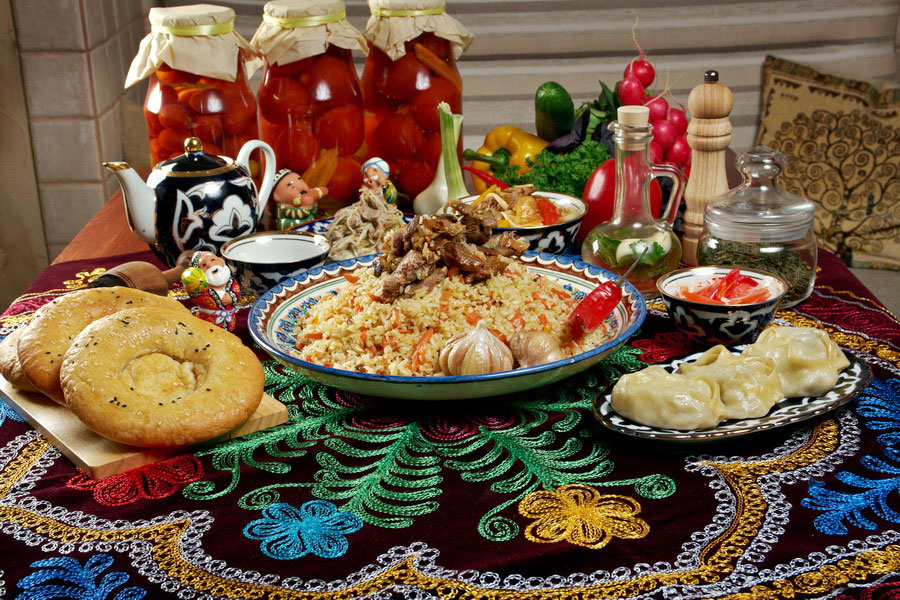Uzbekistan Food is among the most delicious in the world, for over the centuries it absorbed and adapted the best recipes from neighboring cultures to create a flavorful and satisfying cuisine. A highlight of Uzbek cuisine in comparison with its Central Asian neighbors is that they enjoy not only meat dishes but vegetables and salads too. In fact, Uzbek fruits and vegetables are so good that they are exported to other countries.
This was not always the case, however. Until the 19th century the local diet consisted mostly of meat, dough, milk and cereals. Meat, particularly beef and lamb, remain the basis of the local diet today. Horse meat is also enjoyed as a delicacy, while poultry is less popular. Fish dishes are rather uncommon in this double-landlocked nation. Uzbekistan Food is rich in seasonings which accentuate the flavor of the dishes and leave a pleasant aftertaste.
Uzbeks are very hospitable people who will never let guests go hungry: First, because it will not be easy to decline a true invitation; second, because the Uzbek table is usually replete with food; and finally, because after a filling meal you are likely to be sent home with leftovers.
Uzbek Meat Dishes
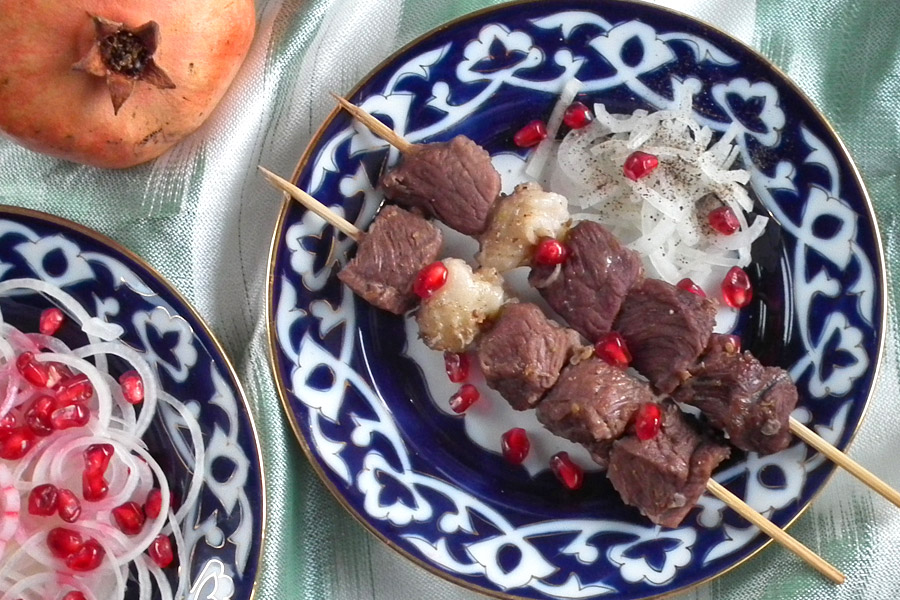
Kebabs, called shashlik, are one of the main meat dishes in Uzbekistan. Shashlik comes in many varieties, including ground beef (lyulya), mutton, beef, chicken, liver and vegetable. Not just anyone can make these tender, juicy, and somewhat fatty kebabs, whose secret marinade recipes are often passed on by word of mouth.
The most famous local roast beef variation is kazan kabob, made with lamb meat still on the bone which is fried in a pot with onions, potatoes and herbs. Dimlama is a roast with vegetables which is layered in a large pot and steamed. Kovurdok (kavurdak) is a roast with onions, potatoes and a little gravy.
Uzbek cutlets called tukhum dulma are made with boiled eggs. Basma is a dish of vegetables and meat (usually lamb) which is stewed in its own juice. Narhangi resembles domlama and basma in the cooking method but is prepared from minced lamb and vegetables.
But the most renowned Uzbek meat dish is plov (pilaf). Traditionally, plov is cooked by men. There is even a special word for such cooks – oshpaz, a title which must be earned. Pilaf is never cooked for just 2-3 people; it is made in huge pots, with each ingredient measured in kilograms. Every region in Uzbekistan has its own pilaf, but the basis is always the same - meat, rice, onions, carrots and spices.
Shavla is a dish made from the same ingredients as pilaf, only easier to prepare. Dolma are stuffed grape or cabbage leaves. Hasip are boiled sausages made from minced meat and rice, and kazy is a horse meat sausage.
Uzbek Soups
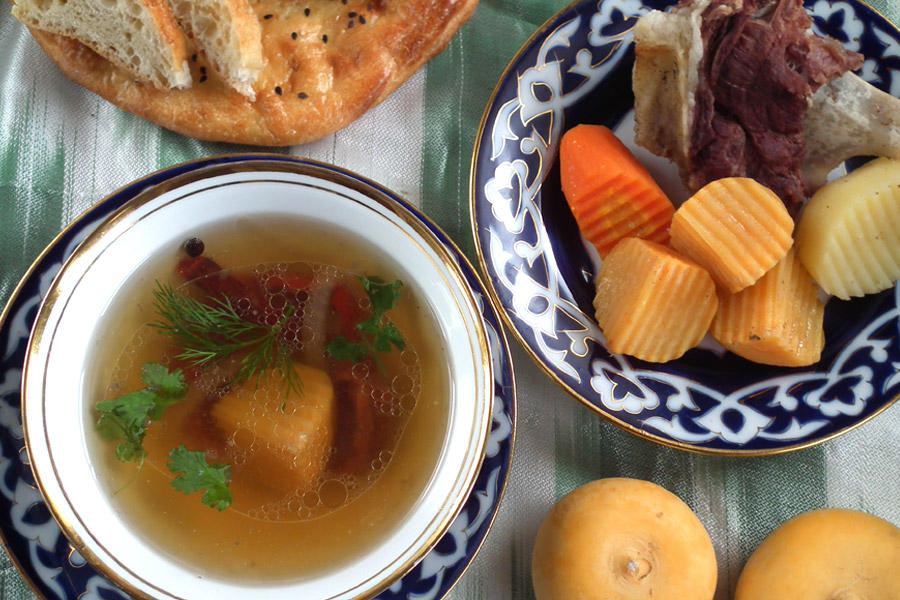
Soups in Uzbekistan are eaten often and are known to be rich and filling.
Shurpa, made from boneless lamb and vegetables, is the most famous Uzbek soup. To cook kovurma shurpa (kaurma shurpa), the meat is pre-fried before cooking. Kuza-shurva is a soup cooked in the oven in a clay pot.
Laghman is made with meat, vegetables and homemade noodles which are stretched by hand in an entertaining way.
Mashhurda is a thick soup made from rice and mung beans. Mastava is a rice soup with beef and vegetables which is often served with sour cream.
Nohat shurak (nohat-shorak) is a chickpea soup with meat that is usually served with a piece of kazy horse sausage.
Uzbek Dairy Products
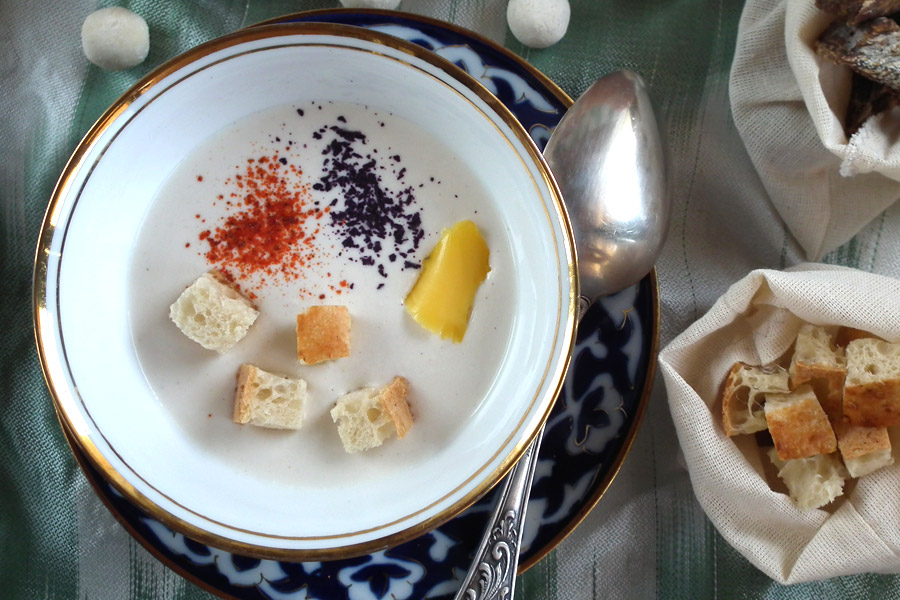
Uzbek dairy products are very popular and may be eaten both as a freestanding dish and as a condiment with soup or a main course.
Katyk is a sour fermented milk.
Suzma is a yogurt made by squeezing the excess liquid from katyk.
Kurt are salted katyk balls up to 5 centimeters in diameter (but often much smaller). They are dried in the sun and can be stored for a long time.
Katykli is a katyk-based soup with meat, rice and vegetables.
Chalop (okroshka in Russian) is a cold soup made from finely chopped vegetables and katyk diluted with water.
Ayran is a drink made from cold, sour milk diluted with carbonated or plain water. Ayran is often salted.
Uzbek Bread
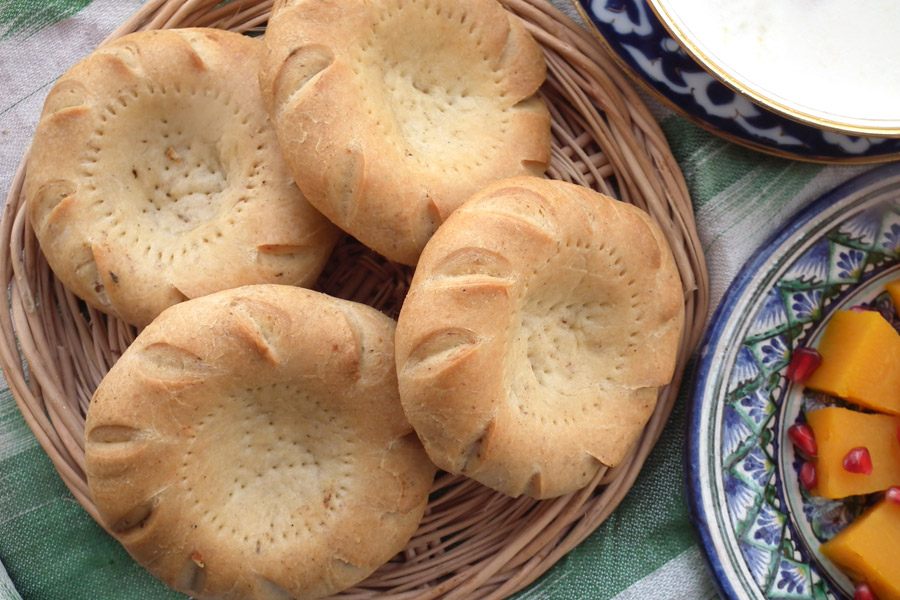
It is impossible to imagine Uzbek cuisine without the most important component - bread. Uzbeks show great respect toward bread; it is broken by hand instead of cut with a knife, and should never be placed face down or thrown away. The most famous Uzbek bread is a white yeast bread called naan which is shaped into a circle and baked in a clay tandoor oven.
The many types of Uzbek bread can be divided into obi-non (made with yeast and water), festive patir naan (a heavier bread made with milk) and flaky breads. Like plov, each region in Uzbekistan has its own variety. For example, in Samarkand naan may be made with onions and meat worked into the dough. In Tashkent large patir naan is popular and in Fergana katlama, a flat bread greased with butter or sour milk, is common.
Uzbek Sweets
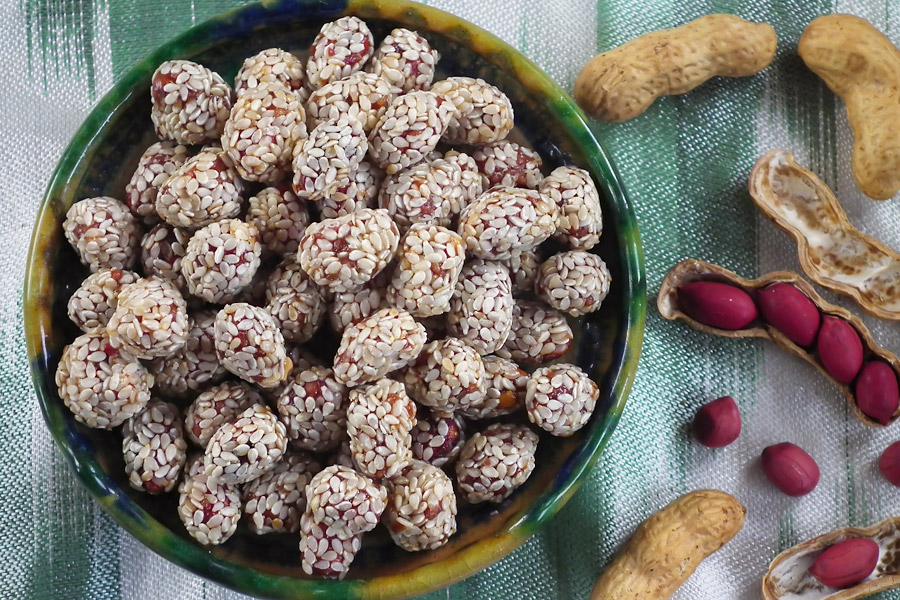
Uzbek cuisine boasts not only of meat and bread, but also sweets.
In Uzbekistan you can enjoy fruits and melons at almost any time of year. In late spring, summer and autumn there are juicy seasonal apricots, sweet and sour cherries, apples, plums, peaches, lemons, figs, grapes, pomegranates, quince, persimmons and many varieties of melons. In winter apples, oranges and dried fruits are available. Uzbekistan’s dried melons and apricots, called turshak, are especially delicious.
Sugar-glazed peanuts are often served with tea, but halva remains the most famous of Uzbek sweets. Runners-up include navat (crystal sugar) nishalda, a white, airy mass made from soap root, and khashtak, a sweet made from nuts and dried fruit.
Pashmak is a flour halva woven from hundreds of thin, sweet threads. Bugirsaki (bogirsoki) are sweet pastries prepared for the holidays. (Unlike Kazakh baursak and Kyrgyz boorsok, the Uzbek variety is eaten as a sweet and not a bread).
Parvarda is a candy that melts in your mouth. Kozinaki are nuts molded together with honey or sugar syrup. Baklava is a puff pastry soaked in honey or sugar syrup, and chak-chak are small pieces of dough fried in oil and soaked in honey.
Turkish delight is made from corn flour and sugar syrup, and holvaitar (halvaitar) a dessert made from flour, sugar, water and butter.
Sumalak is a traditional sprouted wheat dish prepared for Navruz (Persian New Year). It should be boiled in a huge cauldron for almost a day while being stirred continuously.
Uzbek Drinks

Any meal in Uzbekistan begins and ends with tea, the national drink. Traditionally, tea in Uzbekistan is green, although in Tashkent black tea is more common. Tashkent tea is a mixture of black and green tea with honey and lemon.
Tea in Uzbekistan embodies a whole philosophy. Teahouses are still common and are known as places where men can have leisurely conversations while playing backgammon, solving the world’s problems and, of course, drinking tea. There are even local songs dedicated to the traditional teahouse.
In Uzbekistan it is customary to brew tea in a special way. First, the leaves are steeped in boiling water and allowed to brew a little. The tea is then poured into a cup and back into the teapot three times. This ritual is called kaytar (“to return”).
Other common drinks in Uzbekistan include mineral water and kompot, a drink made from fresh or dried fruits.
Uzbek Dough Products
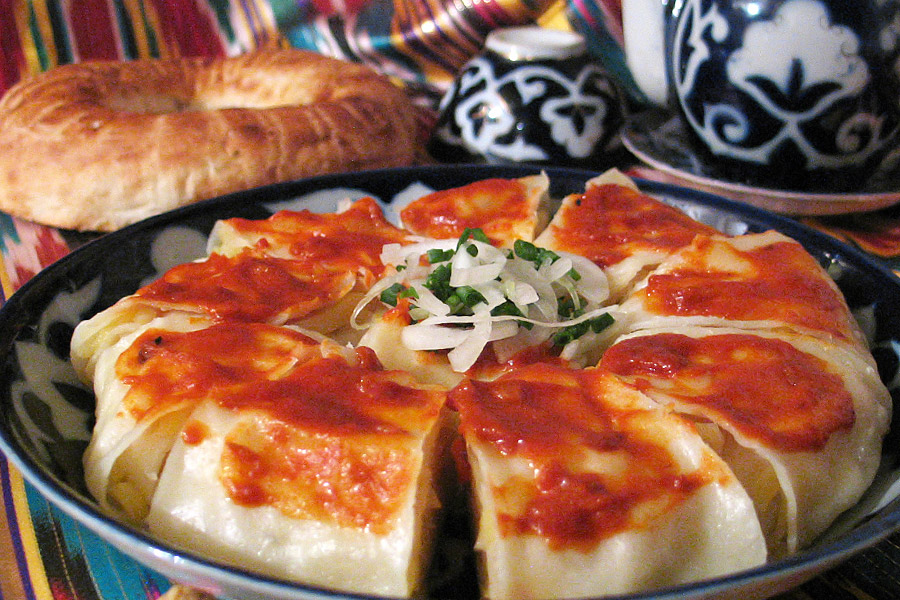
Some claim that after eating Uzbek dough products, they find it difficult to enjoy similar foods in other countries.
Samsas, a famous Uzbek food, are individual pies with a savory filling which are baked in a clay tandoor oven. The dough for samsas is usually flaky and they are stuffed with every variety of filling, including minced meat, chopped meat, chicken, potatoes, mushrooms, spinach and pumpkin.
Gumma samsas are a special samsa variety filled with offal. Although less common today than in past times, when made these tasty samsas are cooked in a tandoor oven and served hot.
Manty are steamed dumplings made from unleavened dough. They are usually stuffed with meat which has been cut into very fine pieces (not chopped or put through a meat grinder), a method which ensures maximal juiciness.
Chuchvara are small boiled dumplings that, like Russian pelmeni, are prepared from unleavened egg dough and a meat filling. Yet unlike the Russian variation, the Uzbek dumplings are usually served in a vegetable broth. Fried chuchvara, with its crispy dough and juicy seasoned filling, is a special delight.
Hanum, like manty, is steamed, but instead of being formed into individual dumplings it is rolled into one large, thin layer which is stuffed with a savory filling and rolled up into a log. Potatoes and onions are the traditional filling for hanum, but occasionally pumpkin or meat may be used.
Shivit-oshi and tukhum-barak are both served almost exclusively in Khiva. Shivit-oshi are green noodles made from a dough to which dill has been added. Meat fried with vegetables are scooped on top of the noodles before serving. Tukhum-barak are square dumplings stuffed with raw eggs which are poured into the dough just before boiling.
Uzbek Salads
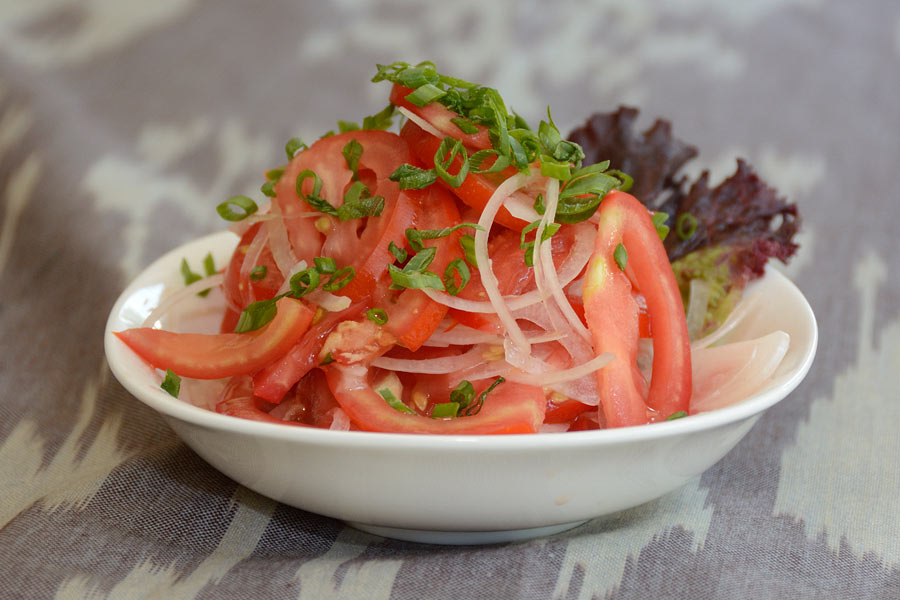
Due to the abundance of vegetables grown in Uzbekistan, salads are always served to guests along with hot dishes.
There are two Uzbek salads that are often confused. Achichuk (achchik-chuchuk) consists of tomatoes, onions and hot peppers (achchik means hot). Shakarob (shakarap) is a sweet salad of tomatoes and onions seasoned with salt (shakar means sweet). A variation of both of these salads includes cucumbers. Traditionally, both achichuk and shakarob are served with plov.
The famous Tashkent salad is made from boiled beef, fried onions and radishes and is sure to please even those who do not ordinarily like this vegetable.
Uzbek Spices

Every food bazaar in Uzbekistan abounds in spices which will beckon you with their aroma: peppers of varying degrees of hotness, cumin, barberry, bay leaves, cinnamon, star anise, herbs, mint, basil, raisins, saffron, turmeric, sesame seeds, cumin and more…
Spices are added to both soups and main dishes and are sometimes selected by tourists as a souvenir. For example, the cumin (zira) in Uzbekistan cannot be found anywhere else.
To say that food in Uzbekistan is a cult is not an exaggeration. With all that it has to offer, Uzbek food rightly deserves to be listed as one of the main attractions of the country.
Uzbek Plov
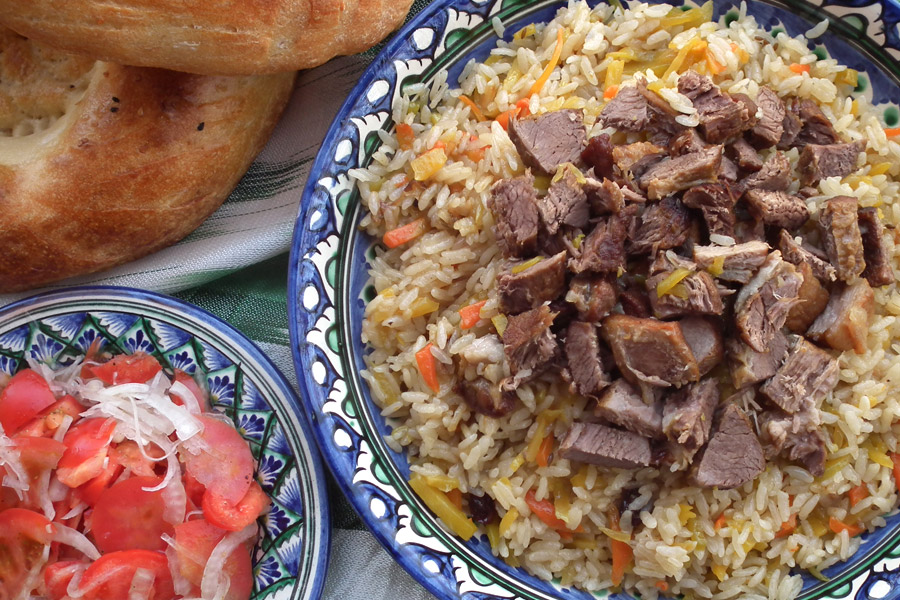
Plov is the symbol of Uzbekistan Food. It is prepared in every Uzbekistan family, whether Uzbek, Russian, Tatar of Korean. Uzbek plov is the part of mentality of Uzbekistan people. Traditionally plov is cooked by men.
Uzbek Vegetables and Fruit

Juicy fruits and vegetables on the table - are symbols of abundance and prosperity of the Uzbek people. Uzbek table - dastarkhan is impossible without serving with greens, vegetables, fruits, sunny melons and juicy bunches of grapes.


